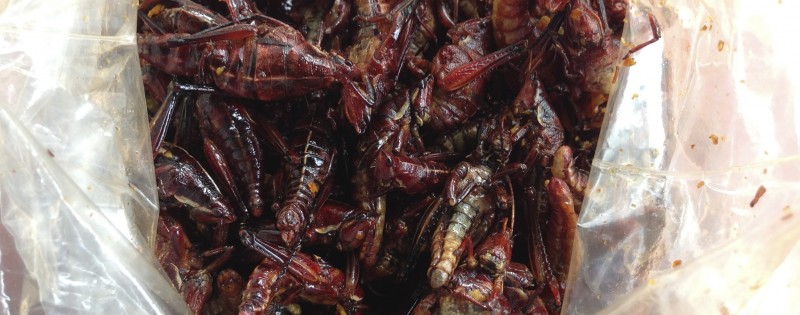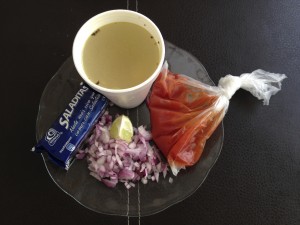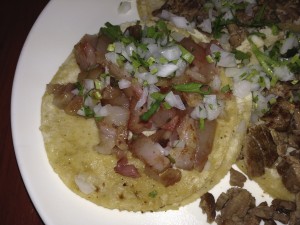
Mexico Travel Tips: How & Where to Eat While on the Move
August 31, 2014|Posted in: Eating Out
 Eating while traveling and on-the-go in Mexico can be a dicey prospect, not because of the various animal parts or insects you might be confronted with that you had never considered consuming before, but because of the real risks to your health that the food may present. We are referring specifically to food-borne bacteria and parasites. Take it from us, being stuck on a toilet (or infinitely worse, between toilets!) or being required to visit a medical clinic, then give fecal samples, and then take hard-hitting medications to clear up whatever you contracted sucks. Follow our suggestions below to help ensure that you stay healthy while traveling so that you can get the most enjoyment possible out of your trip and have smooth sailing after returning home.
Eating while traveling and on-the-go in Mexico can be a dicey prospect, not because of the various animal parts or insects you might be confronted with that you had never considered consuming before, but because of the real risks to your health that the food may present. We are referring specifically to food-borne bacteria and parasites. Take it from us, being stuck on a toilet (or infinitely worse, between toilets!) or being required to visit a medical clinic, then give fecal samples, and then take hard-hitting medications to clear up whatever you contracted sucks. Follow our suggestions below to help ensure that you stay healthy while traveling so that you can get the most enjoyment possible out of your trip and have smooth sailing after returning home.
Don’t eat the fruit or vegetables that you buy in street stands, markets, or supermarkets, right off the shelves. The produce should be disinfected first in water with a disinfecting agent added. The agent you use is up to you, but suitable ones include chlorine bleach and ionic silver mixes. We have also used grapefruit seed extract (GSE) products but there is some controversy regarding such solutions. The controversy does not appear to revolve around whether synthetic GSE solutions do indeed disinfect but rather whether it is really effective to use an all-natural GSE solution or even possible to make or find an all-natural GSE solution that works. In any case, bottles of chlorine bleach or ionic-silver-based or GSE solutions are extremely easy to come by in supermarkets and convenience stores throughout the country. Always follow the instructions on the packaging and be aware that if you’re using a chlorine bleach or ionic silver approach, it is recommended to rinse the produce using clean bottled water after you’ve subjected it to a disinfecting soak. Be aware that a fruit with a really thick rind doesn’t give you the protection you think it might. Take a watermelon, for example. While the fruit inside might be safe without treatment, you may carry nasties from the peel into the fruit as you cut into it with a knife if you haven’t disinfected it first. One of the exceptions to this fruits and veggies rule is the banana, as long as you carefully peel it by hand and don’t use a knife to cut it into pieces through the peel. The skin should be enough to protect the fruit inside and in general you peel the skin off and away from the fruit.
 Be skeptical of fresh vegetables and fruits that are served in street food stands and restaurants. Many taco stands on the street serve fresh chopped cilantro, radish slices, and diced onion, for instance. While I love my tacos with all of these toppings and more, you’re taking a gamble as to whether the stand’s proprietors have disinfected the vegetables or have used genuinely clean knives, for that matter. Asking them probably won’t do you any good, as they are likely to want to put your mind at ease for the sake of your business. Same goes with stands that serve cups of freshly skinned and cut fruit like mango. Eat at these stands at your own risk.
Be skeptical of fresh vegetables and fruits that are served in street food stands and restaurants. Many taco stands on the street serve fresh chopped cilantro, radish slices, and diced onion, for instance. While I love my tacos with all of these toppings and more, you’re taking a gamble as to whether the stand’s proprietors have disinfected the vegetables or have used genuinely clean knives, for that matter. Asking them probably won’t do you any good, as they are likely to want to put your mind at ease for the sake of your business. Same goes with stands that serve cups of freshly skinned and cut fruit like mango. Eat at these stands at your own risk.
We wish we could say that you’re completely safe in brick-and-mortar sit-down establishments, but there too, you may need to be wary unless you’re eating at a nice place in the city. Depending on the restaurant, they may or may not disinfect the fresh vegetables that come with your cooked food and they may or may not properly refrigerate the ingredients and they may or may not wash their hands before touching said ingredients.
 What to do, then? Well, aside from buying only prepackaged or processed foods from the grocery store or eating out at expensive places or dull chains like Vips, or asking every restaurant to show you their Distintivo “H” certification, hot, fully cooked food is your safest bet in any situation. Of course if you bounce into a whole-in-the-wall restaurant that uses spoiled or infected meat, this is no safeguard, so if your food smells or tastes strange (we were once served carne asada in Lagos de Montebello that tasted like salted fish – not normal), send it back and order something else or go to a different place. Mexicans send their food and drinks back if they are not to their liking, and you can too – there is nothing culturally offensive in that.
What to do, then? Well, aside from buying only prepackaged or processed foods from the grocery store or eating out at expensive places or dull chains like Vips, or asking every restaurant to show you their Distintivo “H” certification, hot, fully cooked food is your safest bet in any situation. Of course if you bounce into a whole-in-the-wall restaurant that uses spoiled or infected meat, this is no safeguard, so if your food smells or tastes strange (we were once served carne asada in Lagos de Montebello that tasted like salted fish – not normal), send it back and order something else or go to a different place. Mexicans send their food and drinks back if they are not to their liking, and you can too – there is nothing culturally offensive in that.
One of your safest and easiest options for eating out at reasonable prices while on the move is your local food court. Kitchen conditions are probably more secure, including proper refrigeration, employee cleanliness, and safer food-handling techniques. The food court is also where you can find chain restaurants that are following procedures handed down by company headquarters. Plus, you often know what you’re going to get. Additionally, you’ll have a good variety to choose from all in one place, they are easy to find (just go to the local mall or commercial center plaza), it’s fast, again prices are reasonable, and you don’t have to play any guessing games about what days and times they are open.
Don’t get us wrong, we still sample local food, eat in the streets, and to an extent continue to take our chances at times while we’re on the road. However, we’ve also utilized food courts all over the country in a pinch, and they’ve come in very handy.
Leave a Reply
You must be logged in to post a comment.